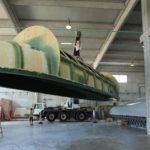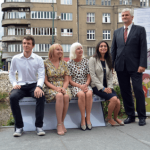When Croatian scientist Dr. Ivana Capan first announced back in the autumn of 2016 that she would develop the prototype of a sophisticated nuclear material control detector with an international team of collaborators, it sounded like an optimistic vision and not much more. We couldn’t have been more wrong.
As Novac/Tanja Rudez writes on the 13th of December, 2019, three years later, Dr. Ivana Capan of the Ruđer Bošković Institute (IRB), fulfilled her promise and recently presented a detector for cargo control and the discovery of special nuclear materials for seaports at a press conference.
This sophisticated silicon carbide-based neutron detector was developed as part of the E-SiCURE project, one of the largest projects in NATO’s Science for Peace and Security programme in Croatia. As the head of the 400,000 euro E-SiCURE project, this Croatian scientist assembled a respectable international team of scientists from the Australian Nuclear Science and Technology Organisation, from the Aveiro University of Portugal, from Japan’s National Institute of Quantum and Radiological Sciences and Technology, and from the Jožef Stefan Institute in Ljubljana, Slovenia.
”As I deal with semiconductors that are the basis of microelectronics and electronics, I’m interested in concrete applications. I was thinking about how to find a small niche where we’d have enough knowledge on it, and this would not require some sophisticated equipment, so I decided to research silicon carbide material. It’s an excellent material and is currently being produced in maximum quantities in Japan. As I have colleagues in Japan, they’ve been my ideal partners. So, we started gathering one consortium that covers everything from material research right up to the finished device. Because our device has a security component, NATO was a logical choice as a source of funding to support such a consortium,” this innovative Croatian scientist recalled.
She also stressed that everything evolved rapidly: from the very first contact between the members of the consortium to the start of work on the E-SiCURE project (Modifying silicon carbide for enhanced security at borders and ports). Of the 396,500 euros, which is how much this project is worth, as much as 31 percent of the funds have now arrived where they need to be in Croatia.
”Current neutron detectors are mainly based on He-3, a naturally occurring helium isotope. The helium isotope used until recently is a legacy of the Cold War, and its supplies are projected to be completely consumed in the next ten years. Therefore, scientists are trying to find quality new materials for detector development,” said Dr. Capan, adding that the idea was to make an inexpensive neutron detector that would be easy to use.
”For the past three years, we’ve devoted ourselves to seeing if we can make such a detector at all. And we did it: the whole system is complete, and it’s simple – plug it into a laptop and see the signal right away.
Our detector is one to four square millimetres in size. With it, for example, we can detect neutrons from so-called ”dirty” nuclear bombs. This makes this detector specific and harder to create. We’re now working on its further development and we’ve already signed up for the continuation of the project, in NATO, too. The results of the tender will be announced early next year,” said Dr. Capan.
One end user of this very sophisticated device could be Croatia’s own customs administration, but so far, only the Slovenian Ministry of the Environment, more specifically the Nuclear Safety Administration, has shown interest.
Make sure to follow our dedicated Made in Croatia page for much more.











